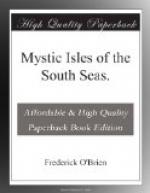Walking one morning along the waterfront, I met two very dark negresses. They had on pink and black dresses, with red cotton shawls, and they wore flaming yellow handkerchiefs about their woolly heads. They were as African as the Congo, and as strange in this setting as Eskimos on Broadway. They felt their importance, for they were of the few good cooks of French dishes here. They spoke a French patois, and guffawed loudly when one dropped her basket of supplies from her head. They were servants of the procureur de la Republique, who had brought them from the French colony of Martinique.
Many races have mingled here. One saw their pigments and their lines in the castes; here a soupcon of the French and there a touch of the Dane; the Chileno, himself a mestizo, had left his print in delicacy of feature, and the Irish his freckles and pug, which with tawny skin, pearly teeth, and the superb form of the pure Tahitian, left little to be desired in fetching and saucy allurement. Thousands of sailors and merchants and preachers had sowed their seed here, as did Captain Cook’s men a century and a half ago, and the harvest showed in numerous shadings of colors and variety of mixtures. Tahiti had, since ship of Europe sighted Orofena, been a pasture for the wild asses of the Wanderlust, a paradise into which they had brought their snakes and left them to plague the natives.
There were phonographs shrieking at one from a score of verandas. The automobile had become a menace to life and limb. There were two-score motor-cars in Tahiti; but as the island is small, and most of them were in the capital, one met them all the day, and might have thought there were hundreds. Motor-buses, or “rubberneck-wagons,” ran about the city, carrying the natives for a franc on a brief tour, and, for more, to country districts where good cheer and dances sped the night. A dozen five- and seven-passenger cars with drivers were for hire. Most nights until eleven or later the rented machines dashed about the narrow streets, hooting and hissing, while their care-free occupants played accordions or mouth-organs and sang songs of love. Louis de Bougainville, once a French lawyer, and afterward soldier, sailor, and discoverer and a lord under Bonaparte, had a monument in a tiny green park hard by the strand and the road that, beginning there, bands the island. He is best known the world about because his name is given to the “four-o’clock” shrub in warm countries, as in Tahiti, which sends huge masses of magenta or crimson blossoms climbing on trellises and roofs. I walked to this monument from the Tiare along the mossy bank of a little rivulet which ran to the beach. It was early morning. The humble natives and whites were about their daily tasks. Smoke rose from the iron pipes above the houses, coffee scented the air, men and women were returning from the market-place with bunches of cocoanuts, bananas, and breadfruit, strings of fish and cuts of meat in papers. Many of them had their heads wreathed in flowers or wore a tiare blossom over an ear.




